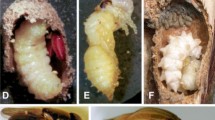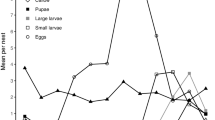Abstract
We used the facultatively social sweat bee Megalopta genalis (Halictidae) to test whether body size is associated with social caste. Behavioral observations showed that non-reproductive foragers were significantly smaller than reproductive nest mate queens, and foragers were also smaller than presumed pre-dispersal reproductives. Moreover, among females from field-collected nests without behavioral observations, relative body size correlated with relative ovary size. Reproductive status is not a direct result of body size, as body size was not significantly associated with either ovary size or fecundity among both solitary and social reproductives. Reproductive status is apparently an outcome of social competition for reproductive dominance, and status is influenced by size relative to nest mates. Our study is the first to demonstrate an association of body size with caste expression in a facultatively social species with relatively weak seasonal constraints on independent nesting. Larvae of a parasitic fly (Fiebrigella sp., Chloropidae) consume pollen provisions stored in nest cells of M. genalis and M. ecuadoria. We tested whether fly parasitism of M. genalis reduces body size. Parasitized females are significantly smaller as adults than their unparasitized nestmates. This reduction is of a similar magnitude to the size differences between castes, and has the potential to shape host reproductive options by influencing competition with nest mates. We present data on the prevalence of parasitism from four collections of M. genalis and two collections of M. ecuadoria from Barro Colorado Island, Panama, and La Selva, Costa Rica.



Similar content being viewed by others
References
Alexander RD (1974) The evolution of social behavior. Ann Rev Ecol Syst 5:325–383
Bouwma AJ, Howard KJ, Jeanne RL (2005) Parasitism in a social wasp: effect of gregarines on foraging behavior, colony productivity, and adult mortality. Behav Ecol Sociobiol 59:222–233
Craig R (1983) Subfertility and the evolution of eusociality by kin selection. J Theor Biol 100:379–398
Crespi BJ, Ragsdale JE (2000) A skew model for the evolution of sociality via manipulation: why it is better to be feared than loved. Proc R Soc Lond B 267:821–828
Danforth BN, Eickwort GC (1997) The evolution of social behavior in the augochlorine sweat bees (Hymenoptera: Halictidae) based on a phylogenetic analysis of the genera. In: Choe JC, Crespi BJ (eds) Social behavior in insects and arachnids. Cambridge Univ. Press, Cambridge, pp 270–292
Engel MS (2000) Classification of the bee tribe Augochlorini. Bull Am Mus Nat Hist 250:1–89
Hughes DP, Beani L, Turillazzi S, Kathirithamby J (2003) Prevalence of the parasite Strepsiptera in Polistes as detected by dissection of immatures. Insect Soc 51:62–68
Jeanson RJ, Kukuk PF, Fewell JH (2005) Emergence of division of labour in halictine bees: contributions of social interactions and behavioural variance. Anim Behav 70:1183–1193
Kamm DR (1974) Effects of temperature, day length, and number of adults on the sizes of cells and offspring in a primitively social bee (Hymenoptera: Halictidae). J Kansas Entomol Soc 47:8–18
Kelber A, Warrant EJ, Pfaff M, Wallén R, Theobald JC, Wcislo W, Raguso R (2006) Light intensity limits foraging activity in nocturnal and crepuscular bees. Behav Ecol 17:63–72
Kudô K, Yamane S, Mateus S, Tsuchida K, Itô Y, Miyano S, Zucchi R (2004) Parasitism affects worker size in the Neotropical swarm-founding social wasp, Polybia paulista (Hymenoptera,Vespidae). Insect Soc 51:221–225
Leigh EG Jr (1999) Tropical forest ecology: a view from Barro Colorado Island. Oxford Univ. Press, New York, p 264
McDade LA, Bawa KS, Hespenheide HH, Hartshorn GS (eds) (1994) La Selva: ecology and natural history of a neotropical rain forest. Univ. of Chicago Press, Chicago, p 493
Michener CD (1974) The social behavior of the bees. Harvard Univ. Press, Cambridge, MA, p 418
Michener CD (1990) Reproduction and castes in social halictine bees. In: Engels W (ed) Social insects: an evolutionary approach to castes and reproduction. Springer, Berlin, pp 77–121
Michener CD, Brothers DJ (1974) Were workers of eusocial hymenoptera initially altruistic or oppressed? Proc Natl Acad Sci USA 71:671–674
Mueller UG (1993) Haplodiploidy and the evolution of facultative sex ratios in a primitively eusocial bee. Ph.D. Thesis. Cornell University, Ithaca NY
O’Donnell S (1997) How parasites can promote the expression of social behaviour in their hosts. Proc R Soc Lond B 264:689–694
Rau P (1933) Jungle bees and wasps of Barro Colorado Island. Von Hoffmann, St Louis, MO, p 324
Richards MH, Packer L (1994) Trophic aspects of caste determination in Halictus ligatus, a primitively eusocial sweat bee. Behav Ecol Sociobiol 34:385–391
Richards MH, von Wettberg EJ, Rutgers AC (2003) A novel social polymorphism in a primitively eusocial bee. Proc Natl Acad Sci USA 100:7175–7180
Roulston TH, Cane JH (2000) The effect of diet breadth and nesting ecology on body size variation in bees (Apiformes). J Kansas Entomol Soc 73:129–142
Roulston TH, Cane JH (2002) The effect of pollen protein concentration on body size in the sweat bee Lasioglossum zephyrum (Hymenoptera: Apiformes). Evol Ecol 16:49–65
Schwarz MP, Richards MH, Danforth BN (2007) Changing paradigms in insect social evolution: insights from Halictine and Allodapine bees. Annu Rev Entomol 52:127–150
Shykoff JA, Schmid-Hempel P (1991) Parasites delay worker reproduction in bumblebees: consequences for eusociality. Behav Ecol 2:242–248
Smith AR (2005) The social biology of the sweat bee Megalopta genalis. Ph.D. dissertation, University of Washington, Seattle WA
Smith AR, Wcislo WT, O’Donnell S (2003) Assured fitness returns favor sociality in a mass-provisioning sweat bee, Megalopta genalis (Hymenoptera: Halictidae). Behav Ecol Sociobiol 54:22–29
Smith AR, Wcislo WT, O’Donnell S (2007) Survival and productivity benefits to social nesting in the sweat bee, Megalopta genalis (Hymenoptera: Halictidae). Behav Ecol Sociobiol 61:1111–1120 doi:10.1007/s00265-006-0344-4
Tierney SM, Gonzalez-Ojeda T, Wcislo WT (2008) Nesting biology and social behavior of Xenochlora bees (Hymenoptera: Halictidae: Augochlorini) from Perú. J Kansas Entomol Soc 81:61–72
Wcislo WT (1997) Behavioral environments of sweat bees (Halictinae) in relation to variability in social organization. In: Choe JC, Crespi BJ (eds) Social behavior in insects and arachnids. Cambridge Univ. Press, Cambridge, pp 316–332
Wcislo WT, Gonzalez VH (2006) Social and ecological contexts of trophallaxis in facultatively social, nocturnal sweat bees, Megalopta genalis and M. ecuadoria (Hymenoptera: Halictidae). Insect Soc 53:220–225
Wcislo WT, Arneson L, Roesch K, Gonzalez V, Smith A, Fernández H (2004) The evolution of nocturnal behavior in sweat bees, Megalopta genalis and M. ecuadoria (Hymenoptera: Halictidae): an escape from competitors and enemies? Biol J Linn Soc 83:377–387
West-Eberhard MJ (1978) Polygyny and the evolution of social behavior in wasps. J Kansas Entomol Soc 51:832–856
Acknowledgements
ARS was supported by an AW Mellon Foundation Exploratory Award from the Smithsonian Tropical Research Institute (STRI) and the Organization of Tropical Studies, the NSF International Research Fellowship Program, and a grant for international collaboration to WTW and ARS from the Secretaria Nacional de Ciencia, Tecnología e Innovación (SENACYT) of Panama; WTW was supported by STRI, the Smithsonian Institution’s Baird Restricted Endowment, and the Smithsonian Scholarly Studies Program, and SO’D was supported by NSF grant NSF-IBN 0347315 and the research presented was also supported by the National Science Foundation, while SO’D was working at the foundation. Any opinions, findings, and the conclusions or recommendations, are those of the authors, and do not necessarily reflect the views of the National Science Foundation. Gogi Kalka and Andre Riveros helped find nests, Jimena Forrera helped rear bees, and the staff of STRI and the Organization for Tropical Studies provided logistical support. Sievert Rowher and Simon Tierney provided helpful comments on the manuscript, and Terry Wheeler identified the flies. Research on BCI was conducted under scientific permit no. 75–99 from the Autoridad Nacional del Ambiente, in accordance with the laws of the Republic of Panama, and research at La Selva was conducted under permission from MINAE in accordance with the laws of Costa Rica.
Author information
Authors and Affiliations
Corresponding author
Rights and permissions
About this article
Cite this article
Smith, A.R., Wcislo, W.T. & O’Donnell, S. Body Size Shapes Caste Expression, and Cleptoparasitism Reduces Body Size in the Facultatively Eusocial Bees Megalopta (Hymenoptera: Halictidae). J Insect Behav 21, 394–406 (2008). https://doi.org/10.1007/s10905-008-9136-1
Received:
Revised:
Accepted:
Published:
Issue Date:
DOI: https://doi.org/10.1007/s10905-008-9136-1




